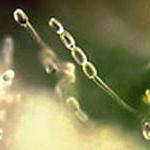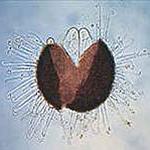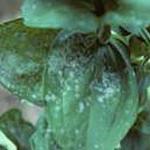Powdery Mildew Diseases of Ornamental Plants
Powdery mildews are among of the most common diseases of ornamentals; many flowers, vegetables, and woody plants are susceptible. Greenhouse crops prone to infection include African violet, Begonia , Dahlia , gerbera daisy, Hydrangea , roses, Verbena, Kalanchoe, and Poinsettia. Herbaceous perennials particularly susceptible to powdery mildew include Aster, Centaurea, Coreopsis, Delphinium, Monarda, Phlox, Rudebeckia, and Sedum.
Signs and Symptoms
The disease is easily recognizable as a white to gray powdery growth on leaves and sometimes stems and flowers. It is usually most severe on the tops of leaves, but can appear on the undersides as well. Mild cases of powdery mildew may have little or no affect on the plant other than diminishing its aesthetic value; on other instances, infected leaves may become distorted, discolored, and die prematurely. In general, powdery mildews have evolved to avoid killing their hosts because they need living plant tissue in order to survive. Symptoms and their severity depend upon the cultivar or species of host plant, the powdery mildew species, environmental conditions, and the age of plant tissue when it first became infected. Sedum develops brown scabby spots that can be mistaken for a leaf spot disease or spray injury.
Disease Cycle
Powdery mildew diseases are caused by fungi in several genera, including Erisyphe, Leveillula, Golovinomyces, Podosphaera, and Sphaerotheca. Each genus contains several species. Most powdery mildew species are specialized to infect only hosts in one plant genus or one family; it is rare that more than one family is affected by a single species. For example, Erisyphe has a wide host range and can infect many plants in the Asteraceae family, while Sphaerotheca pannosa var. rosae is confined to roses. An exception to the rule is Podosphaera xanthii, which infects Calibrachoa, Verbena, and petunia, and also infects cucurbits (pumpkins, squash, melon and cucumber). In this case, it is important to avoid growing squash and cucumber transplants in the same greenhouse as susceptible verbena or calibrachoa.
The distinctive whitish powder on leaves is composed of fine threads of fungal vegetative tissue (mycelium) and light colored mats of asexual spores (conidia). Some powdery mildews produce conidia on short, erect branches that resemble tiny chains, while others form threads so sparse that the mildew cannot be seen without the aid of a microscope. These spores are easily moved by air movement and water splash. Because powdery mildews are obligate parasites, they do not require plant stress or injury to infect plants. When spores land upon a susceptible host, they germinate and send a specialized feeding structure into the epidermis and obtain their nutrients from the plants. The infection process may take as little as 3 days or as long as 7 days. The pathogen survives in the greenhouse in weed hosts or on crops. Outdoors, the pathogen can overwinter as mycelium in infected plant parts or in resting structures (chasmothecia) produced by sexual means and visible as small, dark specks on dying leaves.
Powdery mildews, unlike most other fungal diseases, do not need free water to germinate and infect. They are favored by high relative humidity (greater than 95%), moderate temperatures (68°-86°F), and low light intensities. These diseases are more prevalent in the spring and fall when large differences between day and night temperatures occur. Temperatures above 90°F kill some powdery mildew fungi and spores, and the presence of free water can reduce spore germination.
Cultural Management
Monitor crops on a regular basis for powdery mildew diseases. Epidemics that seem to develop overnight are often the result of undetected low level infections that have spread spores throughout the greenhouse. Rogue infected plants or prune out diseased tissue. Immediately place diseased material into a plastic bag to prevent spores from spreading. The use of resistant cultivars or species is an important management tactic. Although few ornamental crops have been bred for resistance, cultivars of African violet, Begonia, rose, pansy, Zinnia, Monarda, and Phlox with resistance are available. Avoid overcrowding of plants and provide good air movement. Keep relative humidity levels low in the greenhouse by a combination of heating and venting in late afternoon and early morning. Clean greenhouse thoroughly between crops, eliminating all weed hosts and volunteer plants.
Chemical Management
Unlike most fungi, powdery mildews only colonize the surface of plants making chemical eradication possible. It is not necessary to use fungicides to prevent powdery mildew, but numerous products are labeled for the disease. Fungicides with the active ingredients azoxystrobin (Heritage), pyraclostrobin + fluxapyroxad (Orkestra), polyoxin D (Affirm), myclobutanil (Eagle), trifloxystrobin (Compass), and thiophanate methyl (Cleary's 3336) are among the products registered for powdery mildew control on ornamentals. Potassium bicarbonate (MilStop), neem oil (Triact 70), and sulfur are among the organic options. Sulfur may cause plant injury if applied when temperatures are high (greater than 85°F). For a full listing of products, see the New England Greenhouse Floriculture Guide.
Because the genera and species of fungi causing powdery mildews are diverse, there may be some variation in fungicide efficacy across crops. The powdery mildew fungi can develop resistance to any of the fungicides listed above except sulfur and potassium bicarbonate, so be sure to alternate fungicide applications among chemical classes.
References
- Disease Resistant Annuals and Perennials in the Landscape. Purdue University, 2009.
- Powdery Mildew Cross Listing, Penn State Extension, A cross listing of host plants susceptible to powdery mildew.
- Integrated Management for Floriculture and Nurseries. 2001. University of California Integrated Pest Management Project. Publication 3402.
- New England Greenhouse Floriculture Guide. New England Floriculture, Inc.
- Jones, R.K. and D.M. Benson. 2000. Powdery Mildews of Ornamentals and Shade Trees. http://www.ces.ncsu.edu/depts/pp/notes/Ornamental/odin004/odin004.htm
- Pundt, L. Powdery Mildews in the Greenhouse.
- Warfield, Colleen. Squashing Powdery Mildew in Calibrachoa. Grower Talks July 2011.


